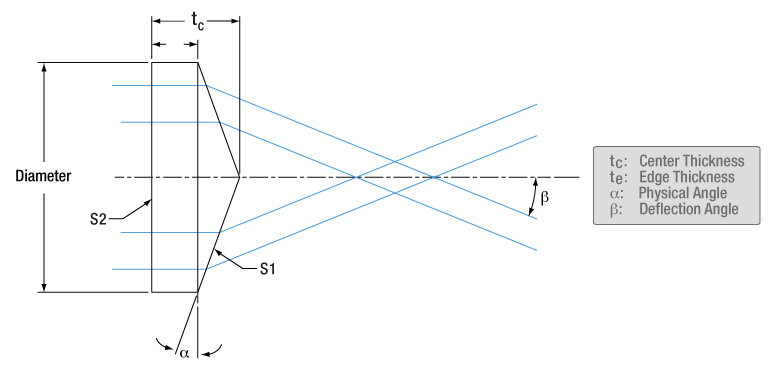Conical lenses are commonly used to generate Bessel intensity distribution beams or conical non diverging beams. When transforming a collimated beam into a circular beam, the plane of the conical lens should face the collimated light source.

When a conical lens refracts light, it follows Snell’s law. Can be used to measure deflection angle:

Among them, n is the refractive index of the glass, α is the physical base angle of the conical lens, and ß is the deflection angle between the refracted light and the optical axis.
Due to the conical shape of the conical lens, a circular beam profile can be generated with the help of an axial prism. The diameter of a circular beam depends on the angle and increases with the distance between the axial prism and the focal plane. Cone shaped lenses are mainly used for beam shaping and various laser applications. They can also be used to generate non diffracting Bessel like beams. An area with an almost constant intensity distribution, whose length is defined by the angle and diameter of the axial cone, is interesting here. Bessel beams are highly suitable for medical, research, and metrology applications. By combining multiple axial prisms or lenses, various beam profiles can be generated, such as collimated annular beams or variable annular focal points.
Main characteristics
- Beam shaping:The most significant function of a conical lens is its ability to convert incident light beams into specific shaped beams, such as converting Gaussian beams into circular beams.
- Modulation beam propagation:By changing the wavefront of the beam, a conical lens can affect the propagation mode of the beam, such as altering the focusing characteristics of the beam or generating non diffracting beams.
- Compatibility of optical materials:Cone lenses can be made of various optical materials, including glass and various transparent plastics, to meet different optical application requirements.
application area
The unique optical properties of conical lenses make them have specific applications in multiple fields:
- laser physics:In laser systems, conical lenses are used to generate circular beams, which are very useful in certain laser processing, optical traps, and optical communication fields.
- optical imaging:In specific imaging techniques, such as ring illumination microscopy, conical lenses are used to generate light beams of specific shapes to improve imaging quality.
- medical optics:In medical diagnosis and treatment, especially laser surgery and photodynamic therapy, conical lenses are used to precisely control the shape and energy distribution of the light beam.
- optical sensing:In optical sensors and photodetectors applications, conical lenses help achieve specific beam shapes and propagation characteristics to improve sensor performance or sensitivity.
A conical lens, also commonly known as a conical lens or conical lens, is a special shaped lens with a conical surface or at least one side. This type of lens is different from traditional spherical or non spherical lenses. It is mainly used for beam shaping, especially in laser physics for generating circular beams or adjusting the propagation characteristics of beams.
advantage
- Highly flexible beam control:Cone lenses provide an effective means of adjusting and controlling the shape and propagation behavior of light beams to meet specific application requirements.
- Compatible with multiple laser wavelengths:According to the selection of production materials, conical lenses can be used for beams of different wavelengths, including ultraviolet, visible, and infrared.
- custom design:Cone lenses can be customized according to specific application requirements to achieve optimal optical performance.
note
- Design and Manufacturing Challenges:The design and manufacturing of conical lenses are more complex than traditional lenses, requiring precise processing techniques to ensure the optical quality of the lens.
- Cost factors:Due to the high processing difficulty, customized conical lenses may have higher costs.
- Application Restrictions:The unique function of conical lenses means that they are primarily used for specific optical applications, and not all optical systems can benefit from them.
conclusion
Cone lens is a highly specialized optical component that plays an important role in precise beam control and special optical applications through its unique design and functionality.
| Cone lens can process conventional indicators | |
| material | optical glass |
| Product Category | conical lens |
| Processing diameter (mm) | 10-300 |
| Diameter tolerance (mm) | ±0.03 |
| Thickness tolerance (mm) | ±0.03 |
| Surface smoothness (American standard) | 60-40 or higher |
| Surface Accuracy | λ/ 10@632.8nm Or higher |
| Focal length error | ±2% |
| Optical aperture | >90% |
| core shift | <3 ‘or higher |
| chamfer | 0.2mmX45° |
| coating film | Customize according to demand |







![62569a303cb73[1] 62569a303cb73[1]](https://asphericoptics.com/wp-content/uploads/2024/09/62569a303cb731-800x701.jpg)